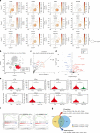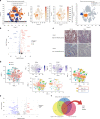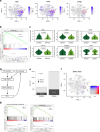Cancer-specific tissue-resident memory T-cells express ZNF683 in colorectal cancer
- PMID: 36869093
- PMCID: PMC10147592
- DOI: 10.1038/s41416-023-02202-4
Cancer-specific tissue-resident memory T-cells express ZNF683 in colorectal cancer
Abstract
Background: Tissue-resident memory T (Trm) cells are associated with cytotoxicity not only in viral infection and autoimmune disease pathologies but also in many cancers. Tumour-infiltrating CD103+ Trm cells predominantly comprise CD8 T cells that express cytotoxic activation and immune checkpoint molecules called exhausted markers. This study aimed to investigate the role of Trm in colorectal cancer (CRC) and characterise the cancer-specific Trm.
Methods: Immunochemical staining with anti-CD8 and anti-CD103 antibodies for resected CRC tissues was used to identify the tumour-infiltrating Trm cells. The Kaplan-Meier estimator was used to evaluate the prognostic significance. Cells immune to CRC were targeted for single-cell RNA-seq analysis to characterise cancer-specific Trm cells in CRC.
Results: The number of CD103+/CD8+ tumour-infiltrating lymphocytes (TILs) was a favourable prognostic and predictive factor of the overall survival and recurrence-free survival in patients with CRC. Single-cell RNA-seq analysis of 17,257 CRC-infiltrating immune cells revealed a more increased zinc finger protein 683 (ZNF683) expression in cancer Trm cells than in noncancer Trm cells and in high-infiltrating Trm cells than low-infiltrating Trm in cancer, with an upregulated T-cell receptor (TCR)- and interferon-γ (IFN-γ) signalling-related gene expression in ZNF683+ Trm cells.
Conclusions: The number of CD103+/CD8+ TILs is a prognostic predictive factor in CRC. In addition, we identified the ZNF683 expression as one of the candidate markers of cancer-specific Trm cells. IFN-γ and TCR signalling and ZNF683 expression are involved in Trm cell activation in tumours and are promising targets for cancer immunity regulation.
© 2023. The Author(s).
Conflict of interest statement
Institutional endowments were received from Taiho Pharmaceutical Co., Ltd., Unitech Co., Ltd. (Chiba, Japan), IDEA Consultants, Inc. (Tokyo, Japan), and Kinshu-kai Medical Corporation (Osaka, Japan) (H Ishii); Chugai Co., Ltd., Yakult Honsha Co., Ltd., and Merck & Co., Ltd (M Konno). KO is an employee of IDEA Consultants Inc. (Tokyo, Japan).
Figures




Similar articles
-
Liver metastases of colorectal cancer contain different subsets of tissue-resident memory CD8 T cells correlated with a distinct risk of relapse following surgery.Oncoimmunology. 2025 Dec;14(1):2455176. doi: 10.1080/2162402X.2025.2455176. Epub 2025 Jan 23. Oncoimmunology. 2025. PMID: 39844661 Free PMC article.
-
Activated tissue resident memory T-cells (CD8+CD103+CD39+) uniquely predict survival in left sided "immune-hot" colorectal cancers.Front Immunol. 2023 May 11;14:1057292. doi: 10.3389/fimmu.2023.1057292. eCollection 2023. Front Immunol. 2023. PMID: 37251410 Free PMC article.
-
The Emerging Role of CD8+ Tissue Resident Memory T (TRM) Cells in Antitumor Immunity: A Unique Functional Contribution of the CD103 Integrin.Front Immunol. 2018 Aug 15;9:1904. doi: 10.3389/fimmu.2018.01904. eCollection 2018. Front Immunol. 2018. PMID: 30158938 Free PMC article. Review.
-
Functional Heterogeneity of CD4+ Tumor-Infiltrating Lymphocytes With a Resident Memory Phenotype in NSCLC.Front Immunol. 2018 Nov 16;9:2654. doi: 10.3389/fimmu.2018.02654. eCollection 2018. Front Immunol. 2018. PMID: 30505306 Free PMC article.
-
Tissue-resident memory T-cell expressions and their prognostic role in head and neck squamous cell carcinoma: a systematic review and meta-analysis.BMC Cancer. 2025 Feb 26;25(1):356. doi: 10.1186/s12885-025-13764-2. BMC Cancer. 2025. PMID: 40011911 Free PMC article.
Cited by
-
Impaired T cell and neoantigen retention in time-serial analysis of metastatic non-small cell lung cancer in patients unresponsive to TIL cell therapy.Nat Cancer. 2025 May;6(5):801-819. doi: 10.1038/s43018-025-00946-x. Epub 2025 May 8. Nat Cancer. 2025. PMID: 40341231
-
Multi-omics analysis of zinc finger protein 683 as a prognostic biomarker for immune infiltration in clear cell renal cell carcinoma.BMC Cancer. 2025 Jul 29;25(1):1236. doi: 10.1186/s12885-025-14643-6. BMC Cancer. 2025. PMID: 40730958 Free PMC article.
-
Liver metastases of colorectal cancer contain different subsets of tissue-resident memory CD8 T cells correlated with a distinct risk of relapse following surgery.Oncoimmunology. 2025 Dec;14(1):2455176. doi: 10.1080/2162402X.2025.2455176. Epub 2025 Jan 23. Oncoimmunology. 2025. PMID: 39844661 Free PMC article.
-
Tissue-Resident Memory T Cells in Cancer Metastasis Control.Cells. 2025 Aug 21;14(16):1297. doi: 10.3390/cells14161297. Cells. 2025. PMID: 40862776 Free PMC article. Review.
-
PD-1 defines a distinct, functional, tissue-adapted state in Vδ1+ T cells with implications for cancer immunotherapy.Nat Cancer. 2024 Mar;5(3):420-432. doi: 10.1038/s43018-023-00690-0. Epub 2024 Jan 3. Nat Cancer. 2024. PMID: 38172341 Free PMC article.
References
-
- Ehrlich P. Über den jetzigen Stand der Karzinomforschung. Ned Tijdschr Geneeskd. 1909;5:273–90.
Publication types
MeSH terms
Substances
LinkOut - more resources
Full Text Sources
Medical
Molecular Biology Databases
Research Materials

